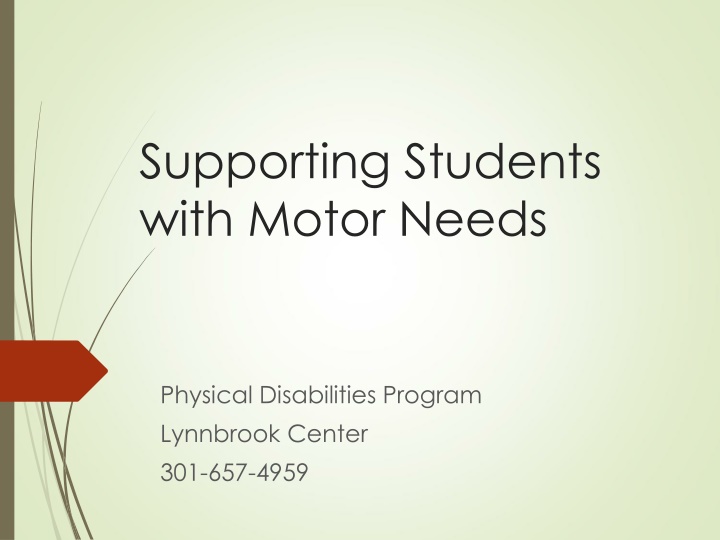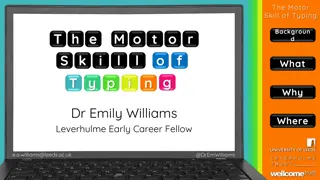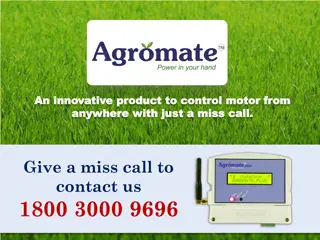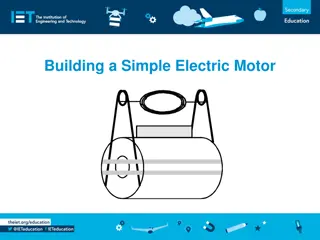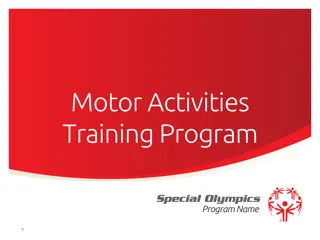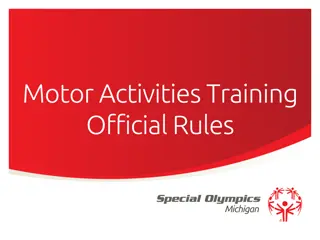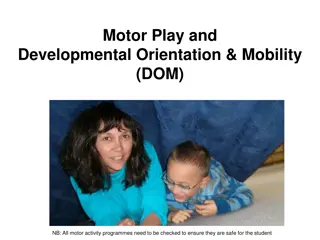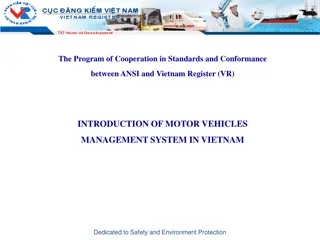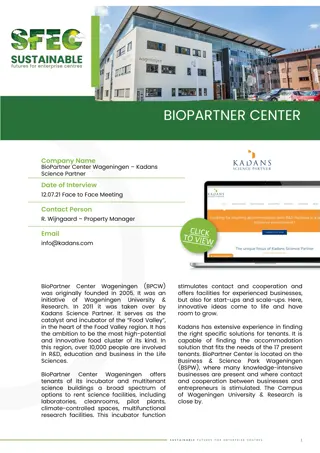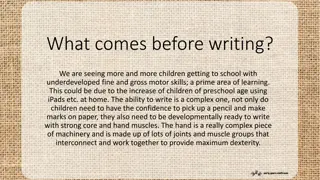Supporting Students with Motor Needs Program at Lynnbrook Center
Exploring a program at Lynnbrook Center that focuses on supporting students with motor needs and physical disabilities. The program aims to educate participants on proper lifting mechanics, posture, working zones, lift types, and safe lifting principles. It emphasizes the importance of safe lifting practices to prevent injuries to students and staff. Attendees will also learn about preschool considerations, positioning equipment, and mobility aids.
Download Presentation

Please find below an Image/Link to download the presentation.
The content on the website is provided AS IS for your information and personal use only. It may not be sold, licensed, or shared on other websites without obtaining consent from the author.If you encounter any issues during the download, it is possible that the publisher has removed the file from their server.
You are allowed to download the files provided on this website for personal or commercial use, subject to the condition that they are used lawfully. All files are the property of their respective owners.
The content on the website is provided AS IS for your information and personal use only. It may not be sold, licensed, or shared on other websites without obtaining consent from the author.
E N D
Presentation Transcript
Supporting Students with Motor Needs Physical Disabilities Program Lynnbrook Center 301-657-4959
Learning Outcomes Upon completion of this presentation, participants will be able to Identify why it is important to lift with proper mechanics. Describe proper posture for lifting. Describe the best and preferred working zones. Identify types of lifts and transfers. Know the proper sequence for preparing to lift. Describe safe lifting principles and strategies. Describe preschool considerations. Identify commonly used positioning and mobility equipment.
Introduction Many of students that you work with have physical conditions that make it difficult to move themselves. These children need to be lifted into and out of adaptive equipment throughout the school day. Unless proper lifting procedures are utilized, injuries to students or staff may occur. This presentation was designed to teach you safe, efficient methods to lift students while performing the duties associated with your job. Please keep in mind that watching this presentation should be done in conjunction with hands-on training. Please contact your school administrative staff for information about training for each student s individual precautions and needs during the lifting process.
Posture Good standing posture Important for you and the student! When viewed from the side: Vertical alignment of feet, hips, shoulders and ears. Pelvis in neutral position with normal lumbar curve (S curve). Knees slightly flexed. When viewed from the front: Symmetrical Feet are shoulder width apart
Good Posture vs. Bad Posture Bad Bad Good Avoid rounded shoulders, flat back, and forward head. Avoid extreme arched back and tucked chin. Ears, shoulders, hips, and ankles should line up.
Best and Preferred Work Zones Performing work within the best and preferred work zones facilitates productivity and comfort. Work is safest when lifting and reaching is performed in these zones. Working outside these work zones results in non-neutral postures that may increase the risk of injury. It is particularly important to perform heavy lifting tasks within the best work zone.
Best and Preferred Work Zones Best Work Zone The zone is a foot on either side of the shoulders. Foot placement as wide as the shoulders. Upper level at about heart height. Lower level at about waist height. (Guidelines, 2004)
Best and Preferred Work Zones Preferred Work Zone As far forward as your hand when you hold your arm out straight. Upper level at shoulder height. Lower level at tip of fingers with hands held at the side. (Guidelines, 2004)
Good Lifting vs. Bad Lifting Good Lifting Bad Lifting Maintain natural S curve. No C curve! Lift by using your leg muscles. Don t use back muscles.
Good Lifting vs. Bad Lifting Good Lifting Examples Back remains upright with S-Curve. Leg muscles are used instead of back muscles. Load is kept in the Preferred Work Zone . Feet are spread for a wide, stable base of support.
Moving Heavy Objects Try to PUSH whenever possible. Avoid PULLING heavy objects. If pulling is necessary, keep good posture!
Types of Lifts & Transfers One person dependent lift (Second staff member acting as a spotter is recommended) Two person dependent lift Floor to stand transfer Sit to stand transfer Pivot transfer Consult the physical therapist assigned to your school for individualized training.
Sequence for a General Lift Transfer Wear comfortable, supportive shoes and appropriate clothing. No open-toed shoes, No flip-flops/sandals. No dangling objects necklaces, earrings, Lanyards should be breakaway. Clothes should permit free movement, but not loose enough to get caught on objects. Always ask for help. Even when a student doesn t require a Two-person lift, consider having another staff member act as a spotter . Assess the load to be lifted. Know the student s weight and their ability to assist.
Plan the maneuver. Talk with the other staff member that will be assisting about the lift before actually performing the lift. Avoid rushing. Think of ways to make the task easier: Reduce the distance to be traveled during the lift. Consider pushing, pulling, rolling, or sliding the student instead of lifting. Clear obstacles in your path. Always consider using mechanical lifting devices. To be determined on a case by case basis.
Communicate with the student what is going to happen during the lift. Make sure all surfaces are stable. Lock wheels on adaptive equipment and wheelchairs. Position equipment against a wall for added support, if possible. Grasp the student in a firm and comforting manner. Position your feet at shoulder s width apart to give you a broad base of support.
Make sure the student is as close to you as possible. Keep them in the Preferred Work Zone Communicate clearly what you plan to do, the sequence, and provide a clear start. (For example 1 2 3 Lift ) While grasping student, bend your knees and keep your back in neutral alignment. Use your leg muscles, not your back muscles to lift. Do not twist your body while lifting or carrying a load. A back injury may result. Pivot your whole body as a unit instead. Move smoothly and calmly, in a secure fashion.
Summary Slide Proper Posture. Vertical Alignment of head, shoulders, hips and ankles Neutral posture (S curve in spine) Best Working Zone. Shoulder width, from waist to arm pit level and out as far as your forearm. Preferred working zone. One foot wider than shoulder width, from the top of the shoulders to arms length down the leg, out to arms length in front of the body. There are several types of student transfers. Two Person lift One person lift (should have a spotter available) Pivot transfer Sit to stand Transfer Floor to stand transfer Lifts must be planned and sequenced before being performed.
Determining the correct technique when lifting students Most appropriate technique to lift is specific to each student. Each student s needs are individualized based on medical conditions, physical needs, and factors such as size (height and weight) and movement ability. Consultation with the school s physical therapist is available if needed. Contact the Physical Disabilities Program at 301-657-4959 to determine which PT is assigned to your school.
Safe Lifting Techniques Avoid lifts that require stretching or bending to reach the student. Redesign the work area so when you lift, the student is close to the body and at waist height. When lifting, keep your back straight and lift with your legs. Lift slowly and carefully and don t jerk the student. Keep the weight of the student as close to your body as possible while lifting. Don t twist or turn your spine while carrying out the lift. Make sure your path is clear while lifting the student. Remove obstacles that could cause you to trip. Avoid prolonged postures/positions and repetitive motions (take breaks). (Controlling ergonomic, n.d., p. 3)
Positioning and Mobility Equipment A variety of different types of assistive equipment available. Speak with the physical therapist regarding specific questions about how to use a piece of equipment or how to help a student transfer from one piece of equipment to another. Types of equipment you might see Wheelchairs, gait trainers, standers Adjustable changing table Lower for transfers and raise for changing Commode chair Adapted strollers and chairs
Wheelchairs For transfers: Place chair at 45 degree angle to transfer surface for pivot transfer. Might be easier to place the chair parallel to the table for two person lift. Lower the table to the height of wheelchair seat. Swing foot rest out of the way. Flip arm rest back.
Gait Trainers Can use different attachments to provide more or less support Can be used for walking or standing Weight bearing is important to a child s development and overall health
Standers Types: Prone stander Supine stander Vertical stander Rabbit mobile stander Benefits: Improves attention to task Promotes weight-bearing Can aide and/or strengthen head and trunk control
Preschool considerations Working at low work heights (e.g. child-size tables and chairs. Options for improved posture: Drop your knees below the level of your hips. Try kneel sitting intermittently. Use adult size chair or rolling stool when possible. Use a chair that allows you to slide your legs under the table. Frequent sitting on the floor with back unsupported: Use the wall or other stable object for back support. Frequently stretch body to upright position.
References Campbell, S. K., Vander Linden, D. W., & Palisano, R. J. (2006). Physical therapy for children (3rd ed.). St. Louis, MO: Elsevier Inc. Controlling ergonomic hazards. (n.d.). Retrieved from WOSH Specialist Training Supplemental Module website https://www.osha.gov/dte/grant_materials/fy11/sh-22240- 11/ErgoHazards.pdf0- 585 Goodman, C. C. & Fuller, K. S. (2009). Pathology: Implications for the physical therapist (3rd ed.). St. Louis, MO: Saunders. Guidelines for retail grocery stores: Ergonomics for the prevention of musculoskeletal disorders (2004). Retrieved from U.S. Department of Labor Occupational Safety and Health Administration website https://www.osha.gov/ergonomics/guidelines/retailgrocery/retailgrocery.html Nonfatal occupational injuries and illnesses requiring days away from work, 2014. (2015). Retrieved from U.S. Department of Labor Bureau of Labor Statistics website http://www.bls.gov/news.release/pdf/osh2.pdf
References (continued) Safe patient handling (n.d.). Retrieved from U.S. Department of Labor Occupational Safety and Health https://www.osha.gov/SLTC/healthcarefacilities/safepatienthandling.html Administration website Waters, T. R., Nelson, A., Hughes, N., & Menzel, N. (2009). Safe patient handling training for schools of Services Occupational Safety and 127/pdfs/2009-127.pdf nursing: curricular materials. Retrieved from Department of Health and Human Centers for Disease Control and Prevention National Institute for Health website https://www.cdc.gov/niosh/docs/2009-
